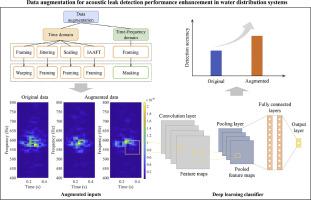当前位置:
X-MOL 学术
›
Water Res.
›
论文详情
Our official English website, www.x-mol.net, welcomes your feedback! (Note: you will need to create a separate account there.)
Advancing deep learning-based acoustic leak detection methods towards application for water distribution systems from a data-centric perspective
Water Research ( IF 11.4 ) Pub Date : 2024-06-24 , DOI: 10.1016/j.watres.2024.121999 Yipeng Wu 1 , Xingke Ma 1 , Guancheng Guo 1 , Tianlong Jia 2 , Yujun Huang 1 , Shuming Liu 1 , Jingjing Fan 3 , Xue Wu 1
Water Research ( IF 11.4 ) Pub Date : 2024-06-24 , DOI: 10.1016/j.watres.2024.121999 Yipeng Wu 1 , Xingke Ma 1 , Guancheng Guo 1 , Tianlong Jia 2 , Yujun Huang 1 , Shuming Liu 1 , Jingjing Fan 3 , Xue Wu 1
Affiliation

|
Against the backdrop of severe leakage issue in water distribution systems (WDSs), numerous researchers have focused on the development of deep learning-based acoustic leak detection technologies. However, these studies often prioritize model development while neglecting the importance of data. This research explores the impact of data augmentation techniques on enhancing deep learning-based acoustic leak detection methods. Five random transformation-based methods—jittering, scaling, warping, iterated amplitude adjusted Fourier transform (IAAFT), and masking—are proposed. Jittering, scaling, warping, and IAAFT directly process original signals, while masking operating on time-frequency spectrograms. Acoustic signals from a real-world WDS are augmented, and the efficacy is validated using convolutional neural network classifiers to identify the spectrograms of acoustic signals. Results indicate the importance of implementing data augmentation before data splitting to prevent data leakage and overly optimistic outcomes. Among the techniques, IAAFT stands out, significantly increasing data volume and diversity, improving recognition accuracy by over 7%. Masking enhances performance mainly by compelling the classifier to learn global features of the spectrograms. Sequential application of IAAFT and masking further strengthens leak detection performance. Furthermore, when applying a complex model to acoustic leakage detection through transfer learning, data augmentation can also enhance the effectiveness of transfer learning. These findings advance artificial intelligence-driven acoustic leak detection technology from a data-centric perspective towards more mature applications.
中文翻译:

从以数据为中心的角度推进基于深度学习的声学泄漏检测方法在配水系统中的应用
在配水系统(WDS)泄漏问题严重的背景下,许多研究人员专注于开发基于深度学习的声学泄漏检测技术。然而,这些研究往往优先考虑模型开发,而忽视数据的重要性。本研究探讨了数据增强技术对增强基于深度学习的声学泄漏检测方法的影响。提出了五种基于随机变换的方法——抖动、缩放、扭曲、迭代幅度调整傅立叶变换(IAAFT)和掩蔽。抖动、缩放、扭曲和 IAAFT 直接处理原始信号,同时对时频频谱图进行掩蔽操作。来自现实世界 WDS 的声学信号得到增强,并使用卷积神经网络分类器识别声学信号的频谱图来验证功效。结果表明在数据分割之前实施数据增强以防止数据泄漏和过于乐观的结果的重要性。其中,IAAFT 脱颖而出,显着增加了数据量和多样性,识别准确率提高了 7% 以上。掩蔽主要通过迫使分类器学习频谱图的全局特征来提高性能。 IAAFT 和掩蔽的顺序应用进一步增强了泄漏检测性能。此外,当通过迁移学习将复杂模型应用于声学泄漏检测时,数据增强还可以增强迁移学习的有效性。这些发现将人工智能驱动的声学泄漏检测技术从以数据为中心的角度推向更成熟的应用。
更新日期:2024-06-24
中文翻译:

从以数据为中心的角度推进基于深度学习的声学泄漏检测方法在配水系统中的应用
在配水系统(WDS)泄漏问题严重的背景下,许多研究人员专注于开发基于深度学习的声学泄漏检测技术。然而,这些研究往往优先考虑模型开发,而忽视数据的重要性。本研究探讨了数据增强技术对增强基于深度学习的声学泄漏检测方法的影响。提出了五种基于随机变换的方法——抖动、缩放、扭曲、迭代幅度调整傅立叶变换(IAAFT)和掩蔽。抖动、缩放、扭曲和 IAAFT 直接处理原始信号,同时对时频频谱图进行掩蔽操作。来自现实世界 WDS 的声学信号得到增强,并使用卷积神经网络分类器识别声学信号的频谱图来验证功效。结果表明在数据分割之前实施数据增强以防止数据泄漏和过于乐观的结果的重要性。其中,IAAFT 脱颖而出,显着增加了数据量和多样性,识别准确率提高了 7% 以上。掩蔽主要通过迫使分类器学习频谱图的全局特征来提高性能。 IAAFT 和掩蔽的顺序应用进一步增强了泄漏检测性能。此外,当通过迁移学习将复杂模型应用于声学泄漏检测时,数据增强还可以增强迁移学习的有效性。这些发现将人工智能驱动的声学泄漏检测技术从以数据为中心的角度推向更成熟的应用。
















































 京公网安备 11010802027423号
京公网安备 11010802027423号